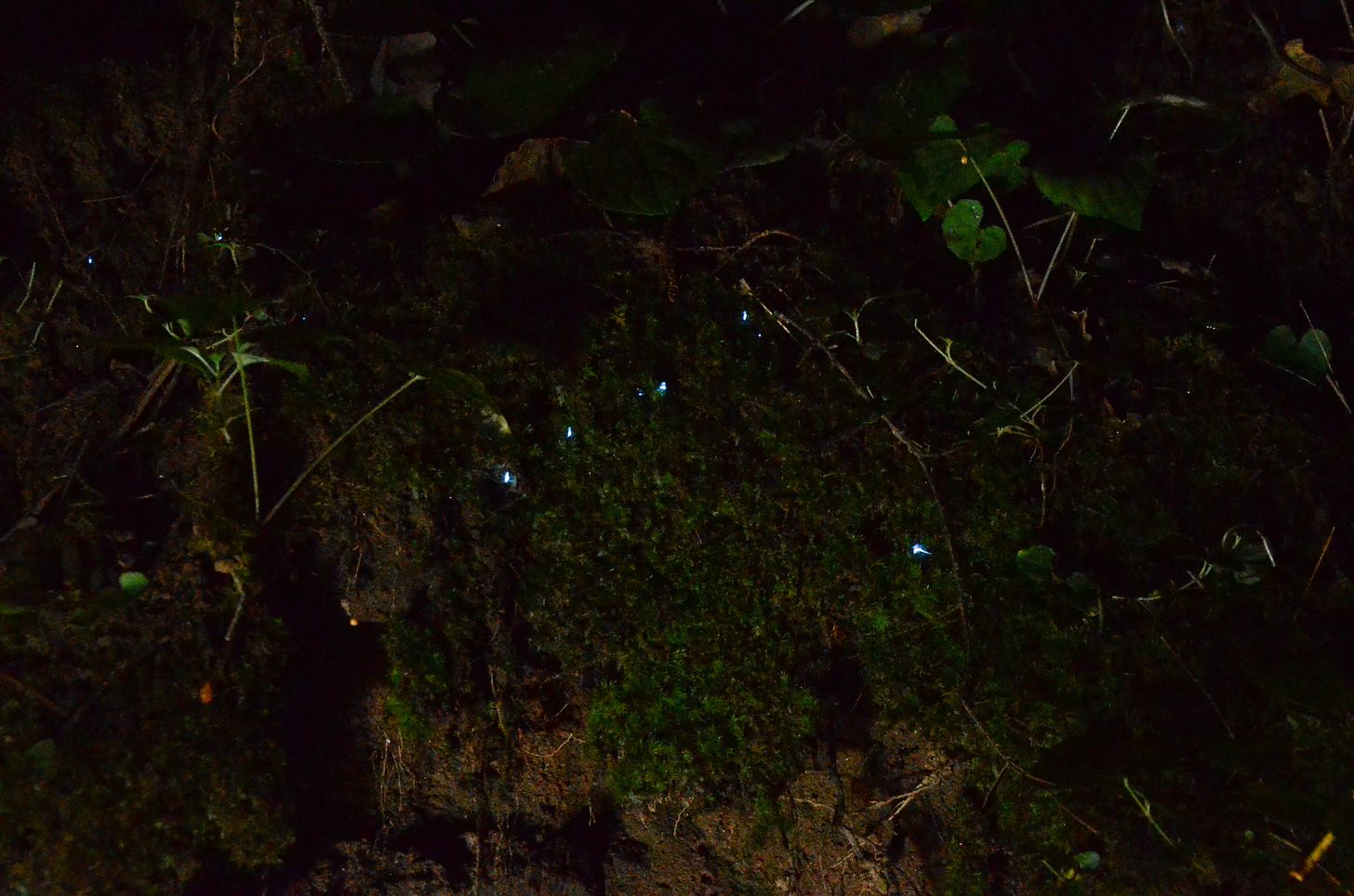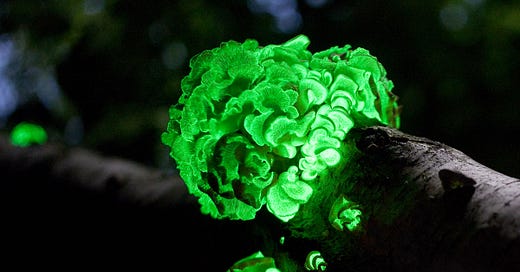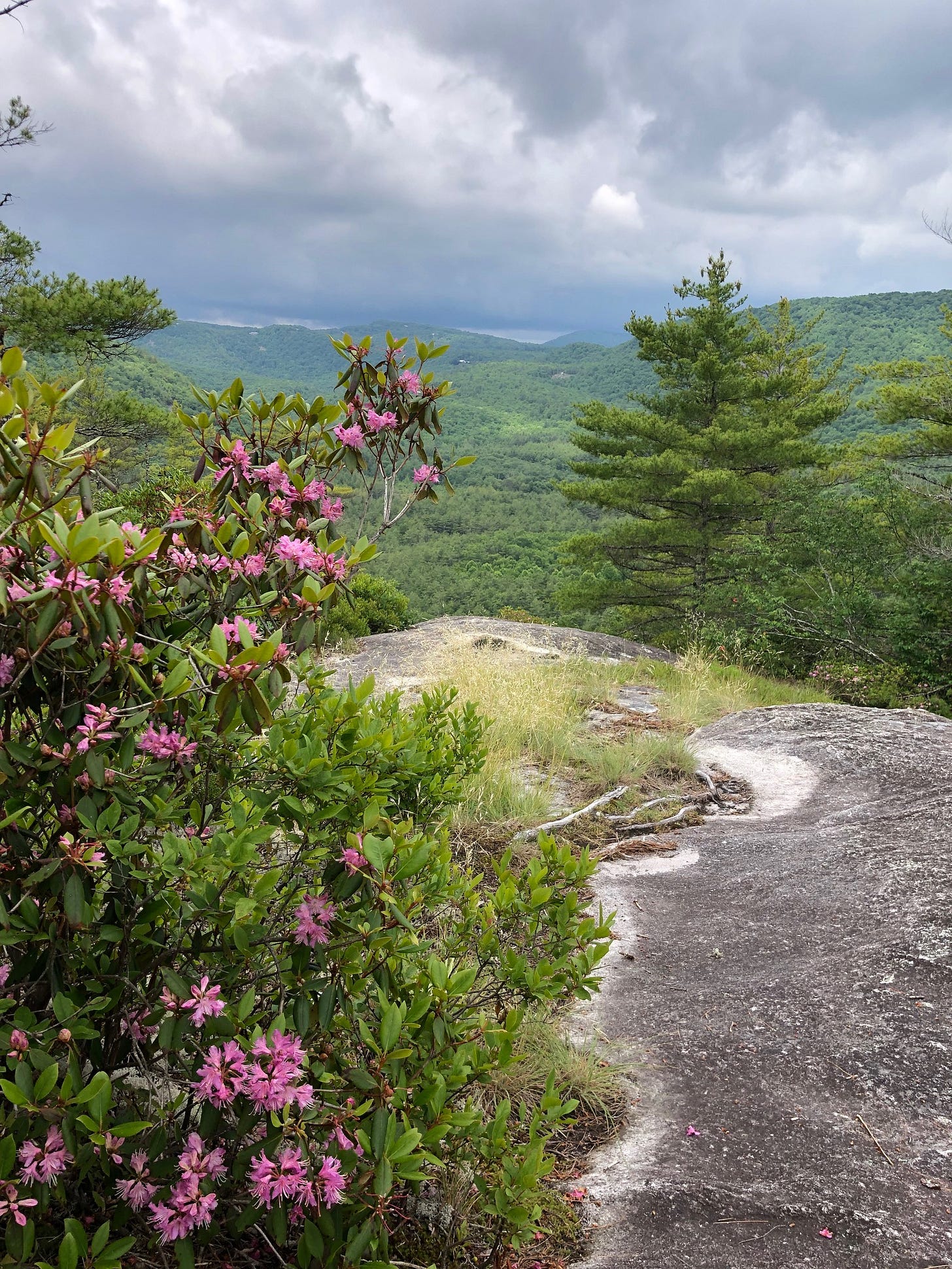Welcome to Natural Wonders! It’s summertime in the northern hemisphere, and a perfect time to get out and enjoy the natural wonders around you. I hope you’re finding time to get out and explore — if you come across anything that makes you say Huh? please comment or reply to this email with anything you’d like me to research. Several topics over the past few months have come from readers’ questions. This issue, however, stems from my own recent experience…

A couple of weeks ago I was quite excited to get a rare reservation for a Foxfire hike at our local state park. Foxfire, along with being a well-known organization of student writers/researchers here in North Georgia, is also a type of woodland fungus that glows in the dark. I’ve never seen it, but I grew up in North Carolina hearing about its ethereal glow from local mountain folk.
Andrew and I arrived at the park at dusk, along with around 35 other (thankfully non-rowdy and woods-respecting) people who had signed up for the hike and paid their $14 for the privilege. While I was in the bathroom, Andrew spotted a bear cub crossing a log upstream, which caused quite a stir with the crowd since that’s the direction we would be traveling momentarily.
As the guide described to the gathered group what we would see once darkness fell, it turned out that we were not actually going to see true Foxfire fungus. Rather, what the locals had called “foxfire” for years had been discovered, in the mid-90s, to be a type of fly larva called Orfelia Fultoni. It is the only fly in North America with bioluminescent larva and has the bluest light of any terrestrial bioluminescent creature. The larvae prefer wet rocks and are really only visible when it’s very dark since otherwise they are translucent. So, the plan was to hike half a mile with the group up the cove where we would later encounter the glowing blue fly larva.


Several of us at the front of the group spotted the bear again, far up on the hillside and probably wondering what so many humans were doing in his woods after hours. He disappeared too quickly for me to get a good picture.
We arrived at Anna Ruby Falls, a double waterfall that crashes 150 feet down a large rock face, and spent the next hour absorbing its negative ions and waiting for complete darkness.


And then that’s when the unexpected magic happened.
Andrew and I wandered a bit down the path, away from the others, and noticed the fireflies lighting up the upper story of the forest. Gradually, they sank with the darkness until, as it became hard to see the person beside you, the fireflies descended around us.
It seemed as if they somehow knew where the people were and avoided us. But just down the trail we could see them flash – a few together, then a sprinkle of several more, then a ripple outward and upward, then a long pause. Nothing. Total blackness.
One one-thousand… two one-thousand… three one-thousand…
Then, three flashed together, then another group nearby, and suddenly the hillside was covered in pulsing light rippling up the hillside like flashing fairy lights. Each display was punctuated by a 3 to 4 second pause of complete darkness, though far off fireflies across the creek and above the trees continued to flash at their own rhythm.
It seemed that we’d stumbled across a population of synchronous fireflies.
Slowly people began to realize what was happening and tiptoed down around the bend. The only sound was the awed, Wow, as people watched the hillside pulse and flicker.
Eventually, the guide realized he was losing us and frantically tried to round us up and focus our attention on the fly larva, which was just beginning to glow, but I kept getting distracted by the pulsing fireflies. I knew there was a population of synchronous fireflies at Elkmont, in the Great Smoky mountains almost 100 miles north of us, but viewing them has become a circus – people have to enter a lottery for a chance to ride a shuttle along with over 100 other people to the Elkmont campground.
I had pretty much given up on ever seeing synchronous fireflies since I didn’t relish the idea of joining a mob in the forest for the privilege. And yet here they were, unexpectedly and delightedly.
What causes these particular fireflies to flash in sync with each other? And why are fireflies flashing anyway? It’s an odd phenomenon when you think about it, animals that can produce their own light…

Why do fireflies synchronize?
Fireflies are a type of beetle. They spend most of their lives, 1-2 years, in the larval stage crawling around the forest floor eating snails and other small insects. Once they mature to the adult stage that we’re familiar with they only live 3-4 weeks, just long enough to find a mate and make summers magical for humans.
Fireflies have different flash patterns depending on their species and so the flashes help them find mates within their own species. Female fireflies look for specific flash patterns when choosing a mate. Males usually flash as they fly while the females remain stationary and flash in response.
Why do a very few species flash synchronously? From the Park Service:
Scientists studying the synchronous firefly have determined that the males flash in unison as a way for the female to be certain she is responding to one of her kind. There are other firefly species flashing at night, and some of them are predatory, so she must be able to recognize males of her species.
At first, the males just synchronize their pauses, like we saw on our hike to Anna Ruby falls. But after a while they will synchronize their flashes as well, until the entire group is pulsing as one.
They are producing what’s called a “cold light” because it contains no heat. It’s a simple chemical reaction in the beetle’s abdomen caused when oxygen combines with various proteins and enzymes produced by the firefly. The flashing on and off has to do with the supply of oxygen for the reaction to occur.
This process is called bioluminescence and occurs throughout the animal kingdom, including in 76% of ocean life. Jellyfish emit the brightest light of any bioluminescent creature.
Amazingly, I discovered that even humans emit light (though we can’t be considered bioluminescent since there’s no chemical reaction). The light we emit is 1,000 times less bright than the lower levels of our eyesight capabilities. We tend to emit more light in the afternoon than the morning, and our faces emit the most light of any place on our bodies. Only extremely sensitive cameras capable of detecting single photons can capture the light, meaning we can’t be tracked by predatory animals following our glow through the forest. Good news in our case at Anna Ruby falls, since we had at least two confirmed bear sightings.
In case you’re wondering, the glowing fly larva was a cool experience as well. The fly is called Orfelia Fultoni, also known as Dismalites since they were discovered in Dismals Canyon in Alabama. They are very rare, only found in the Appalachians and the Cumberland Plateau.
The larvae build sticky webs and then use their head and tail lanterns to attract small insects. The web has tiny ampules of oxalic acid scattered throughout, and as flying insects land in the web they puncture these tubes and are consumed in acid.
Come for the blue fairy lights, stay for the face-melting acid…

Their glow was much less bright than the fireflies hovering in the air around them. Occasionally a stationary female firefly would pose beside the fly larva and would completely drown out its small, blue light.

While the Orfelia Fultoni fly larva is already very rare, it turns out that fireflies are becoming increasingly endangered as well. A combination of loss of habitat, pesticide use, and light pollution that interferes with their mating habits means several firefly species are threatened or even endangered.

As a final, fascinating aside, it’s interesting to consider our names for these luminescent beetles. This article argues that in the American South we call them “lightning bugs” (which is true – I grew up with that term) because the south is a hotbed of severe summer weather. Whereas in the western U.S. they’re more often called fireflies – and that tends to be the part of the country that sees more wildfires.
In those western states, these flickering beetles probably more closely resemble floating embers from a fire, whereas here in the South we can confuse them with the flashes of heat lightning on a summer evening.


I’m hopeful wherever you are and whatever you call them, that you can watch these fascinating, flickering creatures decorate the night sky this summer.
Weird Nature:
For once, I have my own weird nature to submit. Below is a 5- or 6-foot-long black snake eating baby birds out of a nest above our bathroom window — on the second floor. You can see just to the left of the window how the snake has braced himself between the board and batten — that’s how he climbed all the way up the wall. On the left is a DIFFERENT rat snake attempting to make his way over to the buffet. Andrew blasted them both with a water hose, but not before all the baby phoebes were gone. The snakes were safely transferred elsewhere on the property.








What a totally wonderful experience! I was excited myself to see you mention the Firefox students. I didn't know they were still a group. Andrew Wiggonton started this group at Rabun Gap-Nacoochee School in GA. In 1975 they published their first books about Appalachian life and I purchased the set of 6 books, which should be on the shelf of every prepper who hopes to know how to continue to live in a world that has no modern conveniences. Using these books you can know what wild plants are safe to eat, build a log cabin, make a wagon, or spin your own cloth. They are also rich in insights and personal history and stories of the Appalachian people.
Heather! This is magical, and I learned so much! I was just talking with a friend about how we both grew up calling them "lightning bugs." She's from Maryland and I'm from Ohio, so according to the purple and orange map of the country, we're right on target. How interesting that younger generations are using "fireflies" more frequently!